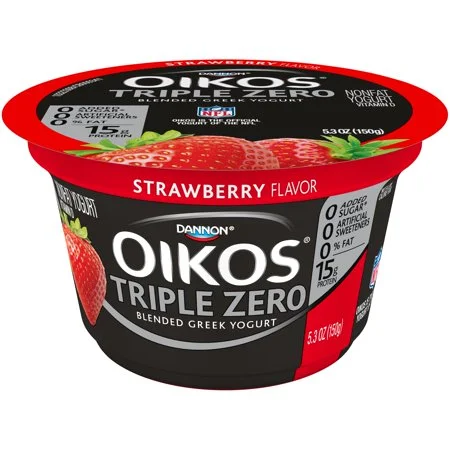Navigating the Yogurt Aisle
Does the yogurt aisle overwhelm you? If so, you’re among the majority. Not only is the aisle itself massive, yogurts tend to be laden with nutrition claims and marketing, adding even more confusion. Yogurts are definitely not created equal. In fact, they can vary from a high protein nutritious snack to a glorified pudding cup. I’m hoping my overview and product recommendations here help you to navigate what I might argue is the most confusing section of the grocery store.
First off- why do I care so much about yogurt? Yogurt is a great staple and extremely versatile. It can be an incredibly satiating protein rich snack, breakfast or even a healthy condiment or basis for dressings and sauces. It’s also one of the best sources of calcium if you’re not a fan of fluid milk.
Lactose intolerant? Some people can tolerate yogurt since the lactose in yogurt is partially broken down by the added bacteria. However, this is incredibly individual. A lot of companies are now making lactose free yogurts.
Vegan or allergic to milk products? There are now many options for soy, almond or coconut-based yogurts.
A little step by step guide to choosing a yogurt:
1) Check the sugar content on the nutrition facts panel- the lower the better. An ideal option is less than 10 g per serving. Note: see my callout on artificial sweeteners in step 4. If you see less than 5 of sugar for a flavored option, be wary of the ingredients list.
2) Check the protein content. Ensure there is at least 10 g per serving. Icelandic or Greek style yogurts tend to fit the bill.
3) Check the saturated fat content- pick an option with less than 3 g per serving. While I’ll admit that this is the least important of the three, I still recommend opting for a lower fat option. You can also be sure you’re getting a lower fat option by choosing a 0 or 2% fat variety (advertised on the front).
4) If it’s a flavored yogurt, confirm there are no artificial sweeteners. You can do this by reading the ingredients list. Stay clear of anything with sucralose, aspartame, acesulfame potassium, or sugar alcohols (anything with an -ol ending such as xylitol, sorbitol, malitol). Stevia is a natural sugar free sweetener and perfectly fine in a yogurt.
Yes, I hear you, going through that list can make choosing a yogurt seem like a part-time job. I wanted you to have the facts, but feel free to follow my recommendations below for my favorite choices:
Best All Around Option: Plain 0 or 2% Greek Yogurt
By choosing plain, you don’t have to worry about brand as much since there shouldn’t be any added sugar. Since I believe in complete transparency, I’ll admit that I’m not a huge fan of plain when eaten solo. I like to use plain in smoothies since there’s already going to be some sweetness from added fruit, or as an alternative to sour cream. I’m also a fan of adding frozen berries to a container of plain yogurt in the morning and letting them thaw prior to eating as a morning snack. The juices will add a nice sweetness and bonus- your yogurt will be kept cold without refrigeration.
Best Flavored Option: Siggis 0 or 2% Yogurt
I love the thickness of this Icelandic yogurt and the hint of sweetness to cut the tartness of the yogurt. I can confidently say that Siggis is going to be the lowest sugar flavored option on the market (aside from those sweetened with artificial sweeteners- yuck!)
Runner-Up Flavored Option: Oikos Triple Zero
Oikos is now offering a sugar free option that is also free of artificial sweeteners. It’s sweetened with stevia, a natural option. I put Siggis ahead of this since I’m not a huge fan of the aftertaste of stevia and the ingredients list is slightly longer.
Best Plant-Based (Milk Free) Option: Silk Dairy Free Plain (soy based)
I’m a big fan of choosing soy as an alternative to dairy since it tends to have a nutrition profile closer to milk (that is, it is equivalent in protein and calcium content). Unfortunately, most almond and coconut based options tend to be either low in protein and high in saturated fat (coconut). While I’d love to give a thumbs up for a flavored, plant-based option, all of the options out there tend to be quite high on the sugar front. Your best bet is going to be to add some fruit or a tiny drizzle of honey.



